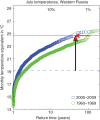Attribution of extreme weather and climate-related events
- PMID: 26877771
- PMCID: PMC4739554
- DOI: 10.1002/wcc.380
Attribution of extreme weather and climate-related events
Abstract
Extreme weather and climate-related events occur in a particular place, by definition, infrequently. It is therefore challenging to detect systematic changes in their occurrence given the relative shortness of observational records. However, there is a clear interest from outside the climate science community in the extent to which recent damaging extreme events can be linked to human-induced climate change or natural climate variability. Event attribution studies seek to determine to what extent anthropogenic climate change has altered the probability or magnitude of particular events. They have shown clear evidence for human influence having increased the probability of many extremely warm seasonal temperatures and reduced the probability of extremely cold seasonal temperatures in many parts of the world. The evidence for human influence on the probability of extreme precipitation events, droughts, and storms is more mixed. Although the science of event attribution has developed rapidly in recent years, geographical coverage of events remains patchy and based on the interests and capabilities of individual research groups. The development of operational event attribution would allow a more timely and methodical production of attribution assessments than currently obtained on an ad hoc basis. For event attribution assessments to be most useful, remaining scientific uncertainties need to be robustly assessed and the results clearly communicated. This requires the continuing development of methodologies to assess the reliability of event attribution results and further work to understand the potential utility of event attribution for stakeholder groups and decision makers. WIREs Clim Change 2016, 7:23-41. doi: 10.1002/wcc.380 For further resources related to this article, please visit the WIREs website.
Figures










References
-
- IPCC . Climate change 2013: The Physical Science basis. In: Stocker TF, Qin D, Plattner G‐K, Tignor M, Allen SK, Boschung J, Nauels A, Xia Y, Bex V, Midgley PM, eds. Contribution of Working Group I to the Fifth Assessment Report of the Intergovernmental Panel on Climate Change. Cambridge, United Kingdom and New York, NY: Cambridge University Press; 2013, 1535 pp.
-
- Hegerl GC, Hoegh‐Guldberg O, Casassa G, Hoerling M, Kovats S, Parmesan C, Pierce D, Stott P. Good practice guidance paper on detection and attribution related to anthropogenic climate change In: Stocker TF, Field C, Dahe Q, Barros V, Plattner G‐K, Tignor M, Pauline Midgley P, Ebi K, eds. Meeting Report of the Intergovernmental Panel on Climate Change Expert Meeting on Detection and Attribution of Anthropogenic Climate Change. IPCC Working Group I Technical Support Unit Bern: University of Bern; 2010, 8 pp.
-
- Stott PA, Allen M, Christidis N, Dole R, Hoerling M, Huntingford C, Pall P, Perlwitz J, Stone D. Attribution of weather and climate‐related extreme events In: Monograph: ‘Climate Science for Serving Society: Research, Modelling and Prediction Priorities.’ Position Paper for WCRP OSC. Accepted as part of monograph of position papers. Dordrecht, Netherlands: Springer; 2013, 307–337.
-
- Cubasch U, Wuebbles D, Chen D, Facchini MC, Frame D, Mahowald N, Winthur J‐G. Introduction In: Stocker TF, Qin D, Plattner G‐K, Tignor M, Alen SK, Boschung J, Nauels A, Xia Y, Bex V, Midgley PM, eds. Climate Change 2013: The Physical Science Basis. Contribution of Working Group I to the Fifth Assessment Report of the Intergovernmental Panel on Climate Change Cambridge and New York: Cambridge University Press; 2013, 119–158.
-
- Seneviratne SI, Luthi D, Litschi M, Schar C. Land–atmosphere coupling and climate change in Europe. Nature 2006, 443:205–209. - PubMed
Publication types
LinkOut - more resources
Full Text Sources
Other Literature Sources
